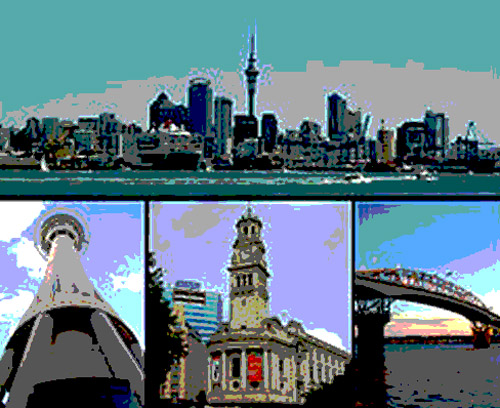
Ali Bell argues that autumn does not exist in Auckland as a three-month long season in the South Pacific.
OPINION: On the first of March something strange happens – television news reporters inform the citizens of Aotearoa/New Zealand it's the first day of autumn. A significant proportion of those hearing this news live in Auckland and Northland. Folk begin to exclaim the new weather conditions and friends send emails overseas telling of the dawning of a new season. The trouble is – it's in all probability a nonsense of enormous Eurocentric postcolonial proportions.
Auckland is humid-temperate and Northland is in a subtropical climate zone, and there is generally no big difference between the climate conditions between the first days of March and the days before and won't be for some time. Actually, this is true for most of oceanic-temperate Aotearoa/New Zealand – all areas apart from the moutainous and alpine regions of our glorious, long and varied country.
Indeed, one can make the argument that Aotearoa/New Zealand doesn't have four seasons at all, and Auckland and Northland have a long warm season and a short cold season, with Auckland being either wet or less wet. The warm season gets cooler or warmer with two short transitional periods in the month of May, and again in September.
Bringing the weather with you
Aotearoa's natural uncolonised state is evergreen (with only two or three naturally deciduous trees growing in a small part of Southland), so there was no changing of the colour of the leaves on trees – a traditional herald of the change of season to autumn in colder climes. And certainly there is no gradual retreat here, into a iced-over snowy state where the foliage goes underground for the winter months unless you live on top of a mountain, or live pretty close to one. In short, there was no such change of season here.
If you think it is the first day of autumn on the first of March, you are being sorely deceived, and perpetuating a fiction generated by homesick northern European colonials, having brought their trout and oak trees among many other reminders of Britain. This fiction gets further supported by the embarrassingly stupid and immature-nation epithet that New Zealand is more English than England, most recently broadcast to the world unfortunately, by Prime Minister John Key on The Late Show with David Letterman, that New Zealand "is like England" ("without the attitude").
Putting the most obvious question aside of why, if you come from the British Isles, and move to the South Pacific islands of Aotearoa, would you want to perpetuate the (generally accepted largely miserable) weather and seasons of that region here? (It seems that homesickness and human beings' tendency to flourish in delusional states answers a lot when it comes to the strange behaviour of folks away from home.) So, apart from that, why say we have entered autumn on the first day of March?
The answer at its most simple is a bunch of European dudes got together in 1780 and decided that the year should be divided into four seasons of equal three-month length. This is a true state for continental central and northern Europe where there is a much greater temperature range than on our place on the planet. Quite simply, the news reporters say it's autumn because the calendar tells them so.
It's all about the tilt
What seasons you experience has to do, in the broadest terms, with what lattitude you live on, ie what angle your piece of Earth's crust is in relation to the sun – its tilt on its rotation around the sun and its relation to the equator and the poles. Aotearoa/New Zealand is at 37 to 47 degrees north of the south pole.
The British Isles, the weather of which we seem to have to live under the auspices of forever after, has in common with us an oceanic temperate climate – but at 50 to 60 degrees lattitude north of the equator and only getting on average 1500 hours of sunlight a year, compared to our 2050 odd here in Auckland with our characteristic humidity – along with the heaps of rain that is where the similarity ends.
Sunlight hours is where it really is at, and if you doubt me on that one, come and live with me in Sweden and we can open up yet another solarium together or another travel website organising bulk autumn and winter tours to the Canary Islands.
Autumn and the equinox
The autumn and spring equinox are the traditional markers of their season, when the sun lies over the horizon and the days and nights are of equal length, and there is a change in the amount of sunlight exposure on your piece of Earth. The autumn equinox is on the 22nd of March this year.
In Europe, particularly northern Europe the four-season year makes a lot of sense. It also makes a lot of sense to our fellow English-speaking post-colonial cousins in northern America, who don't live on the west coast and in the southwest. They actually have four seasons, that's why. When you watch all foliage flora and fauna going underground and being covered by snow, the concept of winter and the Greek myth of Persephone comes to life – or the winter death. And autumn really exists.
What do I mean by really exists? When the temperature must transit from 30 degrees celsius in the height of summer to zero, or 10, 20 or even 30 below zero in winter an autumn takes on a very real meaning. There will be a significant period when the temperature drops rapidly, and the plants start to retreat to their underground, snow-covered existence.
Human beings living there in more simple times had to seriously get their food stores together during the summer to prepare themselves for this period, because there isn't any silverbeet to pick out of the garden for some time, and the cows had better get into a barn or they will freeze to death.
Marching on
Does this happen in Auckland and Northland, and indeed – much of our country? Of course not. March is in fact generally a delightful month with much of the humidity dropping with gentle sea breezes instead, but with beautiful blue skies and sunny days, and of course, that lovely even low-to mid 20s temperatures that makes this area so easy to live in, and arguably one of the main reasons we make it into one of the easiest and most pleasant cities to live in around the world. (Folks, it sure ain't our public transport system.)
Twenty one degrees in the shade, which my garden thermometer stays at most days here in the warm season in Auckland, is the temperature most air conditioning and heating units around the world are set to. And we have it naturally. Way into the month of March. That and most of April, which is when the mornings and nights get cooler, but we're still wearing t-shirts during the day.
Now May – May can get really depressing. Grey skies, precipitation, the wet part of both our warm and cold season comes to the fore, leading us into June and Matariki, the Māori new year around the winter solstice, marked by a constellation in the night sky that becomes visible, telling us the cold season has arrived. It stays around for a few months starts to end in September around the spring equinox and we're back to warm weather, liberally sprinkled with rain.
Lots of rain. That's Auckland for you – the city where you need to pack your umbrella along with the sunhat and sunscreen.
States of confusion
But if you are starting to believe that Aotearoa/New Zealand is confused about its seasons, visit an Australian weather site and like us – they list their three-month long four seasons (and no, the indigenous Australians did not use the year division favoured by Europeans either). Australia, with its tropical regions and desert, is even more confused than we are.
Sense and Matariki
So what's the alternative? We can do what the sensible Scandinavians do and define season changes by average mean temperature (ie in Sweden autumn is when it is below 10 degrees for seven days in a row).
What temperature do we nominate for autumn here in Auckland? See how difficult it gets, and we might ask, why do it at all? Or, we can do what more and more people do here in groovy multi-cultural Auckland, and use the Matariki category – there is a cold season, and then there is the rest.
We could even discuss whether or not Auckland is subtropical.
Watch out for part two of this Ali Bell article, with reply and comment from some of our meterologists, coming up on the equinox!



